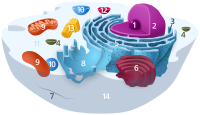
Photo from wikipedia
Summary Despite common consensus about the importance of planar cell polarity (PCP) proteins in tissue orientation, little is known about the mechanisms used by PCP proteins to promote planar polarization… Click to show full abstract
Summary Despite common consensus about the importance of planar cell polarity (PCP) proteins in tissue orientation, little is known about the mechanisms used by PCP proteins to promote planar polarization of cytoskeletons within individual cells. One PCP protein Fzd6 asymmetrically localizes to the apical cell membrane of multi-ciliated ependymal cells lining the lateral ventricular (LV) wall on the side that contacts cerebrospinal fluid flow. Individual ependymal cells have planar polarized microtubules that connect ciliary basal bodies (BBs) with the cell cortex of the Fzd side to coordinate cilia orientation. Here, we report that cytoplasmic dynein is anchored to the cell cortex of the Fzd side via an adapter protein Daple that regulates microtubule dynamics. Asymmetric localization of cortical dynein generates a pulling force on dynamic microtubules connected to BBs, which in turn orients BBs toward the Fzd side. This is required for coordinated cilia orientation on the LV wall.
Journal Title: iScience
Year Published: 2020
Link to full text (if available)
Share on Social Media: Sign Up to like & get
recommendations!